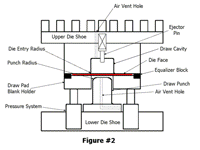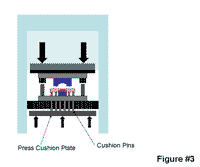Contributing Writer
- FMA
- The Fabricator
- FABTECH
- Canadian Metalworking
Categories
- Additive Manufacturing
- Aluminum Welding
- Arc Welding
- Assembly and Joining
- Automation and Robotics
- Bending and Forming
- Consumables
- Cutting and Weld Prep
- Electric Vehicles
- En Español
- Finishing
- Hydroforming
- Laser Cutting
- Laser Welding
- Machining
- Manufacturing Software
- Materials Handling
- Metals/Materials
- Oxyfuel Cutting
- Plasma Cutting
- Power Tools
- Punching and Other Holemaking
- Roll Forming
- Safety
- Sawing
- Shearing
- Shop Management
- Testing and Measuring
- Tube and Pipe Fabrication
- Tube and Pipe Production
- Waterjet Cutting
Industry Directory
Webcasts
Podcasts
FAB 40
Advertise
Subscribe
Account Login
Search
Die Basics 101: Fundamentals of drawing and stretching
- By Art Hedrick
- Updated July 18, 2018
- December 11, 2007
- Article
- Bending and Forming
Part XVI of this series wrapped up the discussion of bending in stamping operations. This article focuses on drawing.
What Is Drawing?
Drawing is a metal forming process in which a product is made by controlling sheet metal flow into a cavity and over a punch. The process of deep drawing means that the part must be taller than its minimum width.
Many people confuse drawing with stretching. True drawing results in very little stretching of the metal. Drawing requires metal flow, while stretching does not. It is only through the drawing process that objects such as oil pans, beer kegs, and oil filters can be made.
Drawing can be better defined as the process of displacing pre-existing surface into an alternate-shaped vessel containing nearly the same surface area. Stretching can be defined as the increase of surface area that results in a product with more surface area than the original surface area.
Drawing requires the metal to feed inward toward the punch. Very little or no metal flow takes place during stretching. However, keep in mind that because drawing does require tension to pull the metal inward, some stretching occurs during drawing.
The key in deep drawing is to limit the amount of metal stretching and thinning that take place. Items such as oil pans require significant drawing and stretching. Achieving a deep-drawn product that exhibits very little metal thinning requires extensive knowledge of sheet metal properties, drawing ratios, radii, and friction.Figure 1 shows the drawing process.
Basic Drawing Components
the deep-drawing process is not directional-specific. in other words, the direction in which the drawing takes place really doesn't matter. you can draw a part up or down into a cavity. you can even draw a part vertically using cams or special vertical-motion presses.
please keep in mind that i am in no way indicating that process engineers or die designers don't pay close attention to the direction in which are drawing. drawing direction must be given careful attention because it affects the ability to move, cut, and eject the part in the die. if drawing is incorporated into a progressive die, the drawing direction also may affect the die and strip carrierdesign.
Figure 2 shows a section view of a very simple single-action drawing die. this die is designed to produce a round cup with a small flange. a basic drawing die consists of the following components:
1. Die set or foundation. This could be made of mild steel cast iron or aluminum. It serves as the guided foundation on which all of the metal forming sections will be mounted.
2. Draw cavity. The draw cavity represents the drawing die's female portion. Uually made from tool steel or solid carbide, it serves as the cavity in which the metal is formed.
3. Ejectors and knockouts. These pressure-loaded components serve to push or eject the part from the draw cavity. a high-pressure knockout must be timed properly so that it pushes the part out of the cavity after the die has fully separated. If the knockout is timed incorrectly, the part can be crushed during the return stroke of the press.
An alternate method to using a knockout is to use a small ejector pin and a lightweight spring. this spring must have enough force to eject the part adequately but not deform it during the press's return stroke. The pin and spring method does not require specific timing. However, keep in mind that certain part geometries require a great deal of force to eject from the cavity. in such cases, atimed high-pressure knockout may be necessary.
4. Air vents. Air can be trapped during drawing. This trapped air must be vented out of the tool. Not venting the air can cause defective parts, splitting, and wrinkling, as well as make it difficult to strip the drawn part from the cavity.
It is critical that both the cavity and punch contain air vents. Air vents in the cavity allow trapped air to escape during the downstroke of the press; air vents in the punch allow air to be pulled into the punch, which prevents suction during the part-stripping process.
5. Die face. The die face is the surface surrounding the cavity. it can be a flat or a contoured surface. this surface interfaces with the sheet metal and keeps it from wrinkling during the drawing process. the die face typically is made of tool steel or carbide and is highly polished in the direction of metal flow.
6. Draw punch. This component represents the male shape of the drawn part geometry. Like the cavity, it usually is made of tool steel. In most cases, it is polished to a mirrorlike surface. However, there are times when a rough surface is desired.
7. Blank holder /draw pad / binder. This pressure-loaded plate, which serves to keep the metal from wrinkling during the drawing process, typically is loaded with gas springs. However, certain drawing dies can achieve the force needed to control metal flow through the use of a press cushion.
8. Pressure system. The pressure system supplies the force necessary to control metal flow. It may consist of gas, coil, hydraulic, or urethane springs. Certain drawing dies utilize a press cushion to obtain the needed pressure. A press cushion is a plate or series of vertically moving thick, flat plates mounted beneath the press's bolster plate. These plates transfer theforce to the bottom of the draw pad using a cushion pin (Figure 3).
9. Equalizer block. This block functions to maintain a specific gap between the die face and the draw pad surface. It also allows for minor adjustments to be made with respect to how much pressure is being applied to the blank.
Editor's Note:
Part I provides an introduction to stamping.
Part II covers various forming operations.
Part III discusses several production methods used to make stamped parts.
Part IV and Part V cover common stamping die components.
Part VI explains specialty die components.
Part VII provides an overview of metals used in stamping, and Part VIII continues this discussion.
Part IX covers the mechanical properties as well as behavioral characteristics of metals.
Part X begins an in-depth look at the metal cutting process.
Part XI defines slug pulling and common causes.
Part XII describes methods for resolving slug-pulling problems.
Part XIII discusses various specialty metal cutting methods used in stamping operations.
Part XIV explains fineblanking and GRIPflow®.
Part XV describes several bending methods—wipe, coin relief, pivot, and V bending.
Part XVI continues the discussion of bending in stamping operations, focusing on rotary and reverse U bending. It also addresses the advantages and disadvantages of rotary bending.
Part XVII discusses the fundamentals of drawing and stretching.
About the Author

Art Hedrick
10855 Simpson Drive West Private
Greenville, MI 48838
616-894-6855
Related Companies
subscribe now

The Fabricator is North America's leading magazine for the metal forming and fabricating industry. The magazine delivers the news, technical articles, and case histories that enable fabricators to do their jobs more efficiently. The Fabricator has served the industry since 1970.
start your free subscription- Stay connected from anywhere

Easily access valuable industry resources now with full access to the digital edition of The Fabricator.

Easily access valuable industry resources now with full access to the digital edition of The Welder.

Easily access valuable industry resources now with full access to the digital edition of The Tube and Pipe Journal.
- Podcasting
- Podcast:
- The Fabricator Podcast
- Published:
- 04/16/2024
- Running Time:
- 63:29
In this episode of The Fabricator Podcast, Caleb Chamberlain, co-founder and CEO of OSH Cut, discusses his company’s...
- Industry Events
16th Annual Safety Conference
- April 30 - May 1, 2024
- Elgin,
Pipe and Tube Conference
- May 21 - 22, 2024
- Omaha, NE
World-Class Roll Forming Workshop
- June 5 - 6, 2024
- Louisville, KY
Advanced Laser Application Workshop
- June 25 - 27, 2024
- Novi, MI


































